Imagine a world where life has been pushed to its limits. Where the life is nothing like anything you've ever seen, yet looks vaguely familiar. Where ice rules the world, and barely an inch of liquid water covers the ocean. Imagine a world frozen in time.
Snowball Earth[]
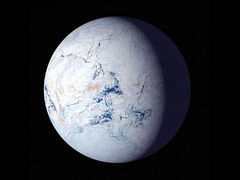
Artist impression of the Cryogenian glaciation
The driving force of evolution during the Phanerozoic eon was none else than the recovery from the snowball earths of the Cryogenian. But this recovery was lucky, and if the large amounts of volcanism signaling the end of the Cryogenian and the dawn of the Ediacaran didn't happen in time, the world would be stuck with an ocean surface as hard as rock. All animal life could perish, and the Precambrian would never end.
What if this was the case? This is a thought experiment which shows what may have happened if the Cryogenian glaciations lasted until end of the Palaeozoic in our timeline. In this world, volcanism and CO2 are at zero and 50 ppm respectively. The buildup and breakup of the supercontinent of Rodinia have stopped plate tectonics almost completely.
The split happened not at the end of the Cryogenian, but at the end of the Hadean eon, after the formation of the Earth. The Late Heavy Bombardment lasted less than 1 million years because of a random change in Jupiter's orbit which stopped it from staying in sync with Saturn. The Earth cooled much more quickly, and this had an effect on plate tectonics. Starting about the same as the plate tectonics in our timeline, the process slowed down because of the quicker cooling of the Earth, and by the breakup of Rodinia, this had accumulated enough to stop nearly all volcanism. The CO2 dropped quickly, and the Cryogenian glaciations became yet more severe, and without break.
Life[]
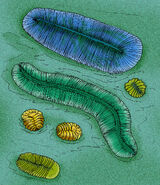
Proarticulata, Dickinsonia and kin
In our oceans, we see familiar life forms like jellyfish, sponges, and algae. But this is no familiar ocean. These are, in fact, the only familiar creatures. Trilobites have many different strange and unusual forms, but the most diverse group compared to Home Earth is the Ediacara biota. Other than arthropods, the only other bilaterian animals are "monoplacophoran" basal molluscs. Life has taken an insane and alien path of evolution. The majority of animals are semiaquatic and ice-loving.
The small plankton niche is taken by an animal phylum which never evolved in our timeline, Mancipia ("slaves"); which are a bit like jellyfish, squid, and krill all in one. The trilobites are mostly benthic, there being little ice on the sea floor, but a select few make up the only flying fauna of this Earth, insect-like trilobites. As for the huge stem-arthropods like Anomalocaris, they became obscure deep sea creatures which stayed nearly isolated from the rest of the world.
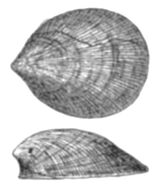
A monoplacophoran viewed from two angles
The Ediacara biota have stayed on par with animals here, having evolved first, and evolved to deal with the snowball earths. Often, they are mistaken for animals; for example, an eyed group of Proarticulata has forms nearly identical those of trilobites, despite being unrelated protozoans. For reference, the term Vendozoa will be used to group together the Proarticulata and Rangeomorpha, with all other Ediacarans being animals. While being seen as primitive and unadaptable, they are more diverse and flexible than animals. When a radiation of non-planktonic, predatory jellyfish occurred, the Ediacara biota already were immune to their stings.
Sponges are nearly identical to those on Home Earth, and this is because of the extremely slow evolution of early animals. Molluscs are fairly common, but generally all in a sessile, hard-shelled form, this being difficult for any predators of this world to eat. While jawed vertebrates would normally feed on these molluscs, they are absent, in fact, chordates had not yet evolved by "second split", when the glaciation became colder and without break.
The jellyfish have conquered this world's oceans, and despite them absolutely lacking any intelligence in our timeline, here they have evolved predatory strategies, including camouflage, speed, and stealth. On land, the first of the Terramedusae, a class of semiaquatic to terrestrial jellyfish, slid on their tentacles on the ice covering the oceans, until they had mastered moving around using nothing but a unique sliding speed mechanism. The relatives of the jellyfish, the Anthozoa, never evolved here, one of the many groups which had already shown that there was a major split before the formation of Pannotia.
History[]
Hadean to Mesoproterozoic[]
The Late Heavy Bombardment was a time in which the Solar System had nearly settled after its formation. The Earth had already accumulated its moon, the planet Theia was gone, and life was destined to begin. In our timeline, a sync in the orbit of Jupiter and Saturn meant that for 200 million years the Earth was an inferno, completely inhospitable, a time when every square centimeter of the Earth was hit by an asteroid or comet. For every two times Jupiter orbited, Saturn orbited once, meaning that every 30 years or so a huge gravitational force sent comets and asteroids towards the inner planets. This affected the outer planets too. Jupiter was sent inwards towards Mars, while all of the planets past Jupiter were sent outwards. Neptune and Uranus switched places multiple times, before finally settling in their current positions.
In this timeline, a huge star passed inside of the Oort Cloud, giving all of the gas giant planets a small tug, enough to destabilise the sync with Jupiter and Saturn, but little enough so that in this timeline Uranus is the furthest planet from the sun. Plate tectonics kicked in on Earth, but eventually slowed down from a lack of heat produced by the asteroids impacting Earth. The course of life was relatively the same, starting 3.9 billion years ago as while the hospitable Earth had come into existence sooner, the essential building blocks of life had come together later, being scarcer from the lack of comet impacts.
Throughout the Archaean and the majority of the Proterozoic, the course of life seemed identical to our timeline. But by the breakup of the supercontinent of Rodinia, plate tectonics came to a halt, and the Earth's continents were essentially locked in the V-shaped supercontinent Pannotia.
Neoproterozoic[]
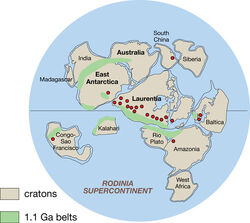
The supercontinent of Rodinia
By the Tonian period, the supercontinent Rodinia had formed, and the last vestiges of the Earth's internal heat were being used up. This led to a series of glaciations parallel to those of Home Earth, but apparently with a different cause. The first occurred during the Tonian, and after the breakup of Rodinia fifty million years later than in our timeline (700 million years ago), it ended with better convection with the open ocean. This long glaciation, lasting 250 million years, was the first signal of the end of the active, tectonic Earth as we know it.
Ironically, in this timeline, the Tonian lasts until 700 million years ago, and the 100 million year break between the two most severe glaciations in history is the Cryogenian. Thus, this timeline technically lacks any Cryogenian glaciations.
By 600 million years ago, the Ediacaran supercontinent of Pannotia had formed, and this stable assemblage of the continents would not be broken up, no matter what happened to the Earth's tectonic plates. A new glaciation occurred almost immediately, and this one is considered the start of the Cenoproterozoic era. This fourth era of the Proterozoic begins a new and remarkable chapter of Earth's history.
Cenoproterozoic[]
Ediacaran[]
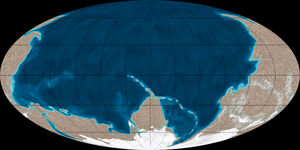
Pannotia, the supercontinent occurring when plate tectonics nearly stopped
The Ediacaran was the period of evolutionary explosion during this timeline. In fact, the term "Ediacaran Explosion" is usually used as an analogy to the Cambrian Explosion. The evolution of the first complex animals and Ediacara biota had happened not long before the Cenoproterozoic glaciation. However, these are mere convergences, and thus these Cnidaria are really para-Cnidaria, the Ediacaran biota para-Vendozoa, et cetera. In fact, slight differences exist with them actually evolving in a warm Cryogenian. The para-Vendozoa, for example, often harbour photosynthesising algae or cyanobacteria to produce food. While this couldn't happen in the little sunlight world of the Home Earth Cryogenian, in this timeline's Cryogenian, the oceans without reflective ice meant that for an organism without a mouth, photosynthesis would be the best option.
These adaptations of the animals of the warm Cryogenian mean that they had to find ingenious ways to find sunlight, liquid water, or prey. For the photosynthesising Vendozoa, this meant they had to be able to reach the surface, but avoid the cold of the nights. For pelagic arthropods, this meant that they had to become creatures of the deep, dark sea, and evolve complex eyes to allow them to see in the midnight zone, one of the only places with guaranteed non-frozen water year round.
In general, the Ediacaran was a time where animals and Ediacara biota evolved a stable ecosystem during a time of glacial chaos. The Ediacara biota had a head start here, some having coped with the Tonian glaciation, though, so they mostly dominated this period. Of course, evolution goes through many failed experiments to pick out the supreme survivors. While the already adapted Vendozoa had little reason to go through this process, animals had every reason to. The animals' evolution would be just a slight bit faster than the Ediacarans', and this would allow them to become apex predators, and force the Vendozoa to either find unusual defenses or become predators themselves. This is exactly what happened during the Cambrian.
Cambrian[]
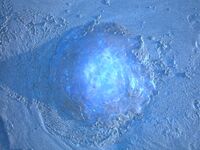
A primitive terramedusan on an icy beach
By the Cambrian, evolution had kicked into overdrive, far more than on Home Earth. The jellyfish had already made it onto land by the beginning of the period. Being the first group to do so, the definition of the Cambrian in this timeline is based on the first appearance of Terramedusae 511 million years ago. Beginning as increasingly stranded jellyfish with a brainless instinct to get away from the ice, entire orders of basal jellyfish (in the class Scyphomorpha, alluding to their similarities to Home Earth Scyphozoa) were going extinct from this cold.
Being jellyfish, though, the obvious answer was to use their highly unspecialised and modifiable body to their advantage to become terrestrial. The trick was not to create a modified respiratory system, jellyfish barely respirate at all. The only problem was obtaining water in a terrestrial environment. This was easily achieved with absorption system with two modified tentacles. Living in a land of ice, they could get water by simply absorbing it from melting ice. Despite the low temperatures, ice was in such great quantities that by all common knowledge some would be melted. Water was indeed all around them, not only on the frozen ocean surface, but also in the sand, and nearly anywhere else the terrestrial jellyfish would end up.
It took nearly the entire Cambrian, however, for the Terramedusae to learn to move around efficiently. Tried methods included using their bells, sliding on their tentacles, and even using a jet-propulsion system driven by the absorbing tentacles found in all members of the group. But ultimately, at the end of the very short Cambrian, 483 million years ago, these would be put to the test. An extinction event caused by a random outward direction in Earth's orbit made the glaciation yet colder. Going from 150 million kilometers to 152 million kilometers from the sun over 5 million years was enough to cause a mass extinction.
Cambrian–Ordovician Extinction[]
The Cambrian–Ordovician extinction affected mainly terrestrial life; although 80% of terrestrial life went extinct, only 30% of marine life went extinct. At the time, only trilobites, jellyfish, and a few select vendozoans had reached land. The aforementioned Terramedusae were the only group of jellyfish to become terrestrial, while the trilobites were represented by the order Paracimices. The Paracimices had an insect-like respiratory system which ultimately failed in response to the extinction. While two orders of the Terramedusae survived, the Paracimices went extinct in the cold, dying the way any frozen insect would.
In the sea, the Dinocaridida may have gone completely extinct. While the last sighting of a stem-arthropod was during this extinction, there may be an unknown relic of this lineage in the deep sea. This might as well be an entirely different planet, for the life of the midnight zone contains every living fossil of this timeline.
Meanwhile, in the sunlight zone and on land, animals are rebounding from the extinction. The glaciation may be coming to an end. The only things that can stop this are the ancient linage of stromatolites.
Ordovician[]
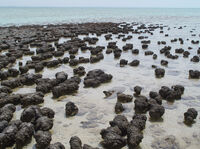
Modern Australian stromatolites, similar to the once again dominant stromatolites of this timeline
Animals inhale oxygen and exhale carbon dioxide. Plants do exactly the opposite. Plants evolved at just the right time in our timeline, as the oxygen was getting sucked out of the atmosphere, creating an extreme greenhouse in the Ordovician until the end of the period. While it may have been a gamma ray burst which stopped the greenhouse, the evolution of plants immediately afterwards certainly helped stabilise the temperatures.
Plants do not exist here. During the Ordovician, animals were bringing the glaciation to an end. By the middle of the Ordovician, the temperatures were up to those of the mid Pleistocene. Out of this abundant CO2, the photosynthesisers were able to go through a radiation, but the line of photosynthesising eukaryotes took a different approach. Instead, the ancient cyanobacteria and their stromatolite colonies were the saviours of this world.
Meanwhile, the algae have formed an unusual partnership with the Vendozoa, which struggle to get food without a mouth or coelom. They are not like jellyfish, which need almost nothing an usual animal would need to survive. The Vendozoa, not animals at all, get their food from a symbiotic partnership with green algae.
As such, the proliferation of animals in the hotter climate is slowed. In the background of all of this action, a practically alien life form emerges. It has a strange new metabolism which allows it to get energy from nothing other than movement.
Silurian[]
They seem to be not of the Biota. They are certainly life by every known definition, but of the simplest kind possible. They are the Kinetica, a group of organisms unrelated to any of the three domains.
While the diversification of the Biota took billions upon billions of years, the at the otherwise unclear Ordivician–Silurian boundary, 448 million years ago, it seemed that a strange bacterium-like organism had suddenly become able to reproduce, have a metabolism, and mutate. Their metabolism is not based off of consumption, however, but off of kinetic energy, hence their name. Their reproduction is by splitting, and their growth by collecting and organising microscopic particles. The strangest of all things is perhaps their mutation, though. They mutate their materials, and in later forms, body parts, by means of not a genetic material, but by means of simple malformation after splitting.
As the Silurian goes on, we begin to see the Vendozoa making a comeback. The Proarticulata begin to develop mouths, and a digestive system. They feed mainly on aquatic jellyfish. The Terramedusae begin to become more advanced in the meantime. Their tentacles have evolved an exoskeleton in place of the jelly, and are becoming more and more like legs.
Going into the Devonian, more predatory niches open up as we see the diversification of Mollusca and Mancipia. One group of superpredators is to take over the apex predator niche in the entire Panthalassic Ocean.
Devonian[]
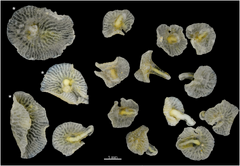
A collection of the unclassified genus Dendrogramma; their single tentacle bears a resemblance to the Aplanteria
As the Scyphomorpha, this timeline's most common group of jellyfish, begin to be preyed upon by new predators of the Proarticulata and of the elusive stem-arthropods, they suddenly turn the tables. This timeline's jellyfish are only rarely carnivorous, but Aplanetaria ("non-wanderers"), an order of predatory jellyfish first evolving in the mid-Silurian, evolve double the ferocity by the beginning of the Devonian. In addition to being predatory, they have a sting more powerful than that of any other jellyfish, and can swim with enough power as not to be considered planktonic. Their sting can be more concentrated due to a fusing of the tentacles to create a single large tentacle.
At the beginning of the Devonian, 402 million years ago, a minor extinction marks the end of several groups of trilobites. The Proarticulata have formed strange camouflaging forms which have basic light sensors, not quite eyes, and a mouth. These bug-eyed creatures might be mistaken for trilobites, but their carnivory and lack of an exoskeleton easily differentiate the two.
Their mouth is simply a gaping hole, through which their simple digestive system is visible, but any sea creatures unlucky enough to get close to the seafloor may find themselves stuck, before realising they are in a closing hole which is the mouth of any of a group of Proarticulata known as Abyssia.
The Aplaneteria feed on trilobites and molluscs with ease, but the Abyssia feed on the predatory jellyfish, without any chance of harm: they are immune to the stings, as are other jellyfish and all Vendozoa. A neurotoxin, the sting can only affect animals with complex nervous systems, that is, only bileterian animals.
Soon, the Carboniferous approaches. The weather approaches the Pleistocene of our timeline once again as it did in the Ordovician. Except there is no Silurian cold spell to end the slowing of animal proliferation. No, this will carry on to the Permian period as well.
Carboniferous[]
As the climate continues to warm as it was since the Late Devonian, more and more groups find themselves becoming terrestrial, as the temperature is not too cold, and there is no worry of getting frozen in the middle of the ocean. A strange trilobite group finds itself beginning to outcompete the Terramedusae. These jellyfish were the sole rulers of the land from the brutal Cambrian–Ordovician extinction until the beginning of the Carboniferous, around 346 million years ago.
Semiaquatic algae, cyanobacteria, and the occasional symbiotic vendozoan make up the appetite of a terrestrial jellyfish. But these resources are just of the right amounts to mean there is no competition between jellyfish, but competition from any other group would deplete them. And these trilobites do just that.
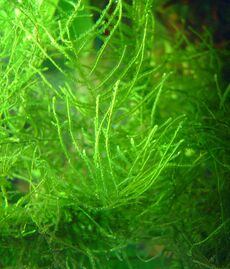
Java moss, a modern analogy to moss-algae
By the Late Carboniferous, beginning around 312 million years ago, the climate has warmed up enough as to stop the ongoing extinction of terramedusans. Moss-algae are a terrestrial group of algae with no vascular system and tiny individual organisms forming colonies, just like moss. This new, plentiful food allows the jellyfish and trilobites to nicely coexist. The jellyfish would have done well anyway, however: one order of the previously sloppy jellyfish, Crassarticulata, has thick front tentacles to lean on while pushing with its back tentacles. The bell seems to serve no purpose at all. Sexual selection does not exist in jellyfish; the bell simply has had no reason to disappear.
Things are going quite nicely at the end of the Carboniferous. There is just one phrase stopping this from carrying on: greenhouse effect.
Permian[]
During the early Permian, beginning 294 million years ago, things are carrying on as before: more terrestrial life, a predator-prey crazed relationship in the sea, and the Kinetica becoming more and more like the Biota. Evolution continues to accelerate, with the Vendozoa evolving into new and unusual niches, and more specialised molluscan and mancipian forms evolving. And then, everything comes to a halt.
An extinction is long, long overdue. The end of the glaciation has been overdue by perhaps an order of magnitude longer. And both are coming together to create the worst extinction event in all of Earth's history. The sun continues to grow, like any other star would. Brighter, hotter, and larger, but only ever so slightly. A prediction of the end of the glaciation could be made 100 million years in advance.
The dying only begins two-thirds of the way through the Permian, but the sequence resulting in it had already commenced by the middle Devonian period. For it was at that time when a greenhouse effect had slowly been taking shape, beginning when the temperatures began to rise in a stable manner. Less and land of the surface of the sea was covered by ice, and a related diversification in photosynthesising life began pumping more carbon dioxide into the atmosphere.
The combination of the dark, hot oceans and this greenhouse gas only became evident, however, considerably later, only about ten million years before the Carboniferous period began. And while in the beginning, this helped the proliferation of perhaps every life form on Earth, by now, it is too late. Beginning in the Ediacaran snowball earth the evolutionary adaptions to the cold were already taking place. In a land of warmth, these cannot hold.
The fate of all creatures in this extinction is sealed. In all evidence, most will go extinct. The ones that survive will live on, through the hardships of the final eon of life on Earth. Or perhaps, life is doomed much sooner.
Only time will tell.
|
Frozen in Time |
||
| Life | Animalia | Arthropoda • Cnidaria • Mancipia • Mollusca • Porifera |
|---|---|---|
| Vendozoa | Proarticulata • Rangeomorpha | |
| Chlorophyta • Cyanobacteria • Kinetica | ||
| Places | Panafrican Ocean • Pannotia • Panthalassic Ocean | |

